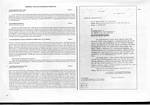|
|
 |
 |
AUSCHWITZ:
Technique
and Operation
of
the Gas Chambers © | |
|
| |
 |
Back |
 |
Contents |
Page 432 |
 |
Home
Page |
Forward |
 |
| |
| CRIMINAL TRACES FOR
KREMATORIUM II |
| |
| 1. |
"Vergasungskeller / gassing
cellar"
[PMO file BW 30/40, page 100] |
[Photo 1] |
| |
|
|
| |
Letter of 29th January
1943. from SS Captain Bischoff, head of the Bauleitung (Auschwitz
Waffen SS and Police Central Construction Management), registered by
SS Second Lieutenant Pollok (Buildings Section) and addressed to SS
Major-General Kammler in Berlin, concerning the progress of work at
Krematorium II, in which the word “Vergasungskeller” is used. The
inspection report enclosed with the letter makes it possible.
through a process of elimination, to establish that Bischoff uses
Vergasungskeller to designate “Leichenkeller 1” of Krematorium II
. |
| |
|
|
| 2. |
“10 Gasprüfer / gas
detectors.”
[PMO file BW 30/40, page 48] |
[Photo 2] |
| |
|
|
| |
Telegram sent on 26th
February 1943 at 1820 hours by SS Second Lieutenant Pollok, signed
by SS Second Lieutenant Kirschneck (Buildings Section specialist and
technician) and by Jährling (civilian employee, heating technician),
to the firm Topf & Sons of Erfurt, requesting immediate despatch
of “10 gas detectors” for B W 30 (Krematorium II) [in order to
check the efficacy of the ventilation system in the gas chamber]. In
the week of 1st to 7th March 1943, the Topf fitter Messing started
up the ventilation and air extraction systems of Leichenkeller I of
Krematorium II and tested them the following week, 8th to 14th, just
before the first homicidal gassing in this room, that of 1500 Cracow
Jews on 14th March. Messrs Topf, manufacturer of metal parts for
incineration furnaces and grain silos, was unable to produce this
type of equipment and must have sub-contracted. |
| |
|
|
| 3. |
“1 Stck Ilandgriff für Gastür
D12 / handle for gas[tight] door, 12 [Ø] diameter” |
[Photo 3] |
| |
|
|
| |
[Volume 11 of the
Hoess trial. Annex 15 concerning the book known as
“Schlosserei WL / metalworking shopWL”. The original
is no longer in the possession of the Auschwitz State Museum, and is
probably conserved in the “October Revolution” Central
State Archives in Moscow. This book contains records of the work
carried out by the metalworking shop for the construction and
maintenance of the Birkenau Krematorien in accordance with orders
issued by the Bauleitung. Some of these orders have survived and are
conserved in the PMO Archives in a black file entitled
“Zentral Bauleitung der Waffen-SS und Polizei. Auschwitz OS
(Bestellscheine für) Deutsche Ausrüstungswerke, Auschwitz OS,
1943-1944 / Waffen-SS and Police Central Construction Management,
Auschwitz. Upper Silesia (order forms for) German Equipment Works,
Auschwitz Upper Silesia, 1943-1944”, now classified as File BW
30/31, comprising 416 pages, microfilm No 1258. Certain extracts
form Annex 14 of volume 11 of the Hoess trial, a report of 22nd
October 1945 indicating the discovery of the file on the Bauleitung
premises. File BW 30/31 is incorrectly referred to as simply the
“Schlosserei” file to distinguish it from the “Schlosserei WL”
file.)
6.3.43,
Nr 162. KGL Krematorium II BW 30.
Order issued by the
Bauleitung on 5th March 1943 under the number 64, received on 6th
March by the DAW metalworking shop under number 162. requesting the
making of “1 handle for gas[tight] door, 12 [mm] diameter” for
Birkenau Krematorium II. It was completed on 10th March. |
| |
|
|
| 4. |
“Auskleideraum / undressing
room”
[PMO file BW 30/25. page 7] |
[Photo 4] |
| |
|
|
| |
Letter of 6th March
1943 front the civilian employee Jährling. signed by the head of the
Bauleitung (now Major) Bischoff, addressed to Messrs Topf. regarding
the possibility of preheating Leichenkeller 1 of Krematorien II and
III (BW 30 and 30a) with air coming from the three forced draught
suction installations [next to the collective chimney]. The
preheating of the Leichenkeller completely demolishes the
revisionist argument according to which the Leichenkeller 1 were not
gas chambers but “typical underground morgues”. Why would anyone
want to heat rooms that by definition ought to remain cool? This
idea would be absurd if there had not been a change of function,
transforming these rooms from morgues into gas chambers, where the
temperature had to be high enough for the product introduced to
vaporize rapidly. This project could be realized only in Krematorium
II, where three “Saugzuganlagen” were actually installed. Because of
overheating problems with the three electric motors in these forced
draught installalions, and a fire caused by one of them [see the
account by Henryk Tauber in Part II Chapter 3], the “Saugzuganlagen”
were dismantled and this forced draught system, also planned tor
Krematorium III, was abandoned, thus also putting an end to this
suggested method of preheating Leichenkeller l. The letter also
mentions a modification in the air extraction system of the
“Auskleideraum / undressing room” [for Leichenkeller 2] without the
Krematorium concerned being specified. Although the term could apply
to either II or III, the date of the letter in relation to the stage
of construction of the two buildings makes it most likely that it
refers to Leichenkeller 2 of Krematorium II, whose function, like
that of Leichenkeller l, had now changed. |
|
 |
Photo
1 | |
| |
AUSCHWITZ:
Technique
and operation
of the gas chambers
Jean-Claude Pressac
© 1989, The
Beate Klarsfeld Foundation |
 |
Back |
Page 432 |
Forward |
 |
|

